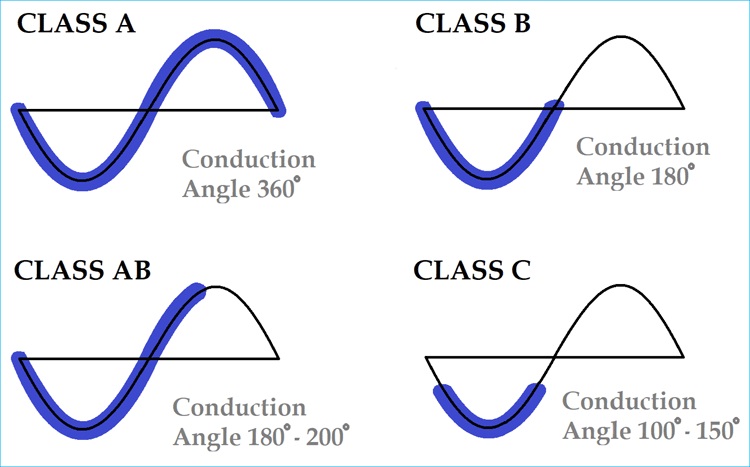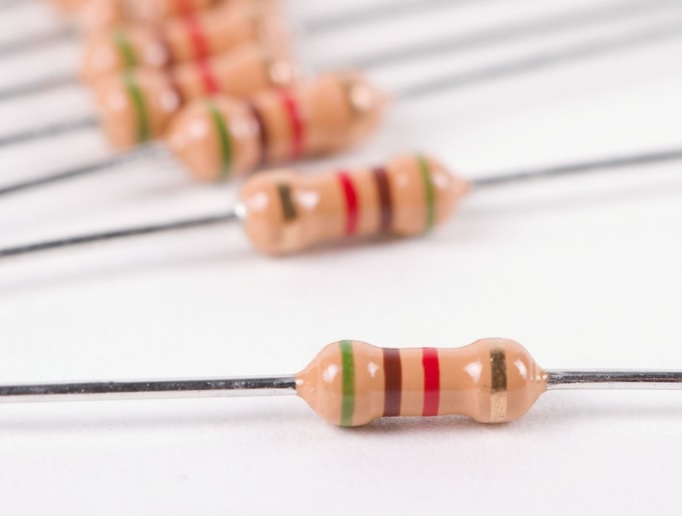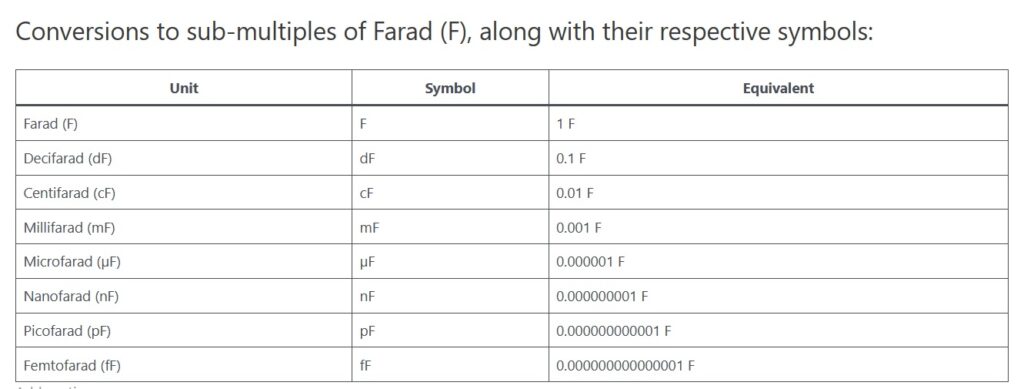An Overview of Different Classes of Amplifiers and Their Comparison
Amplifiers are essential components in electronic circuits, designed to increase the power of a signal. Depending on the application and design requirements, amplifiers can be categorized into different classes, each with unique characteristics, advantages, and trade-offs. This article explores the various classes of amplifiers, focusing on their operating principles, efficiency, distortion, and typical applications.
1. Class A Amplifiers
Operating Principle:
Class A amplifiers are the simplest type of amplifier, operating with a bias point set so that the output transistor is always conducting, even when there is no input signal. This continuous conduction ensures linear amplification with minimal distortion.
The following diagram is a typical class A amplifier circuit with its input and output waveforms:
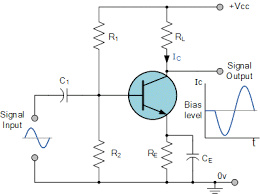
For a more in depth study of class A amplifiers, please go here, where you will find an article specifically written on this matter in full detail explaining its operation, applications as well as n depth advantages and disadvantages of these class of amplifiers.
Advantages:
- High linearity
- Low distortion
- Simple circuit design
Disadvantages:
- Low efficiency (typically around 20-30%) due to continuous power dissipation
- High heat generation
- Requires large heat sinks
Applications:
- High-fidelity audio amplification
- Low-noise applications
- Signal processing where linearity is crucial
2. Class B Amplifiers
Operating Principle:
Class B amplifiers use two complementary transistors, each conducting for half of the input signal cycle (one for the positive half and the other for the negative half). This push-pull arrangement improves efficiency.
The following diagram is a typical class B amplifier circuit with its input and output waveforms:
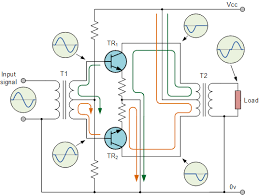
The above diagram is also called “Push-Pull Amplifier” where only one transistor is turned on at any given time amplifying only half a cycle of the input signal. For a more in depth study of class B amplifiers, please go here, where you will find an article specifically written on this matter in full detail.
Advantages:
- Higher efficiency (typically around 70%)
- Reduced power dissipation compared to Class A
Disadvantages:
- Crossover distortion at the point where the signal transitions between transistors
- More complex circuit design
Applications:
- Audio amplification where efficiency is more critical than absolute fidelity
- RF transmission
3. Class AB Amplifiers
Operating Principle:
Class AB amplifiers combine the benefits of both Class A and Class B designs. They operate in Class A mode for small signals and switch to Class B for larger signals, reducing crossover distortion and improving efficiency.
The above is only a very brief description of Class AB Amplifiers. For a more in depth study of Class AB Amplifiers, please go here, where you will find an article specifically written on this matter in full detail.
Below is a typical diagram of a simple Class AB Amplifier:
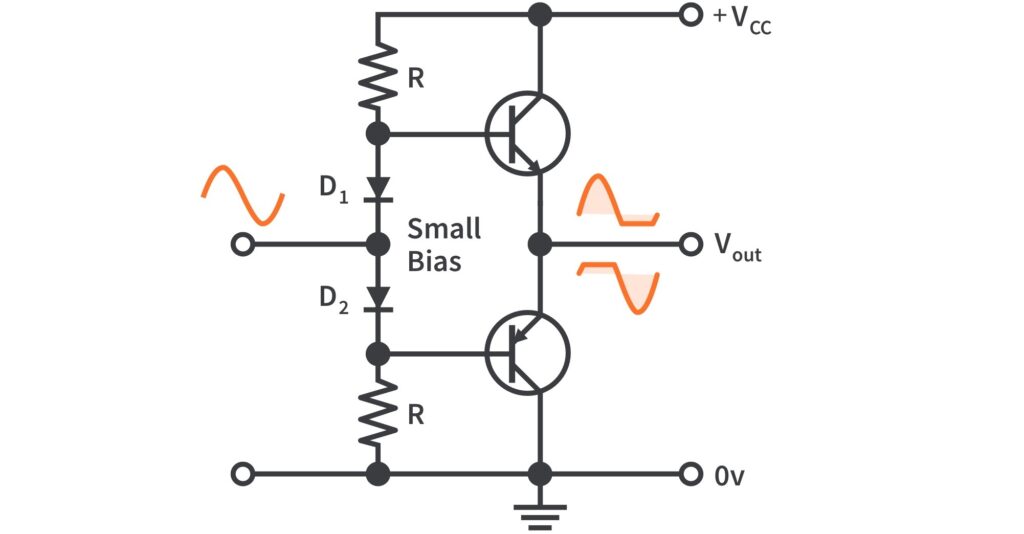
Advantages:
- Better linearity than Class B
- Reduced crossover distortion
- Higher efficiency than Class A (typically 50-70%)
Disadvantages:
- Slightly more complex circuit design
- Higher power consumption than Class B
Applications:
- Audio amplification in consumer electronics
- RF amplification where both efficiency and linearity are important
4. Class C Amplifiers
Operating Principle:
Class C amplifiers operate with a bias point set so that the output transistor conducts for less than half of the input signal cycle. This results in high efficiency but significant distortion.
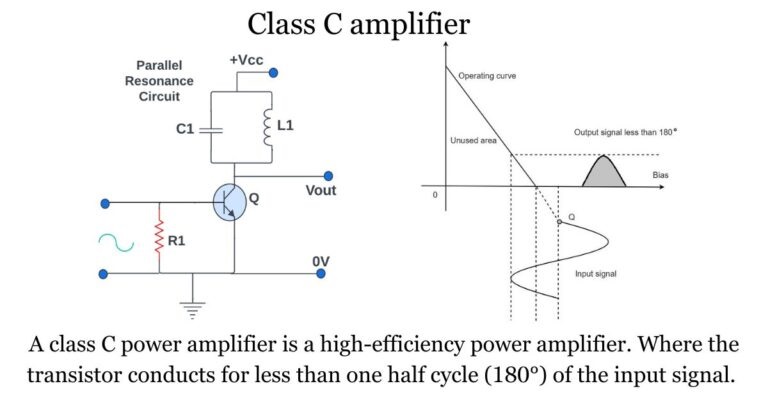
This is of course only a very brief description of Class C Amplifiers. For a more in depth study of Class C Amplifiers, please go here, where you will find an article specifically written on this matter in full detail.
Advantages:
- Very high efficiency (up to 90%)
- Low power dissipation
Disadvantages:
- High distortion, making them unsuitable for audio applications
- Requires filtering to remove harmonics
Applications:
- RF amplification in transmitters where efficiency is critical
- Oscillator circuits
5. Class D Amplifiers
Operating Principle:
Class D amplifiers are switching amplifiers that use pulse-width modulation (PWM) to amplify the signal. The transistors switch on and off rapidly, minimizing the time they spend in the linear region, which enhances efficiency.
Again, the above is merely a very brief description of Class D Amplifiers. For a more in depth study of Class D Amplifiers, please go here, where you will find an article specifically written on this matter in full detail including its applications and diagrams.
The following is a Class D Amplifier Block Diagram with its waveforms:
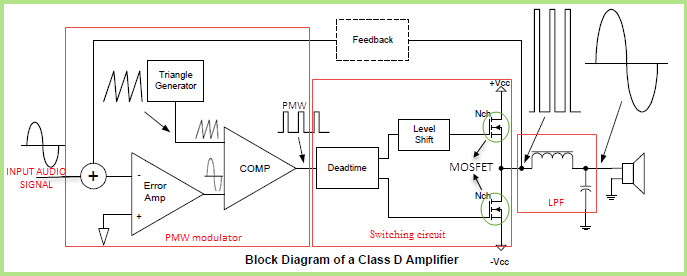
Advantages:
- Very high efficiency (typically above 90%)
- Compact and lightweight design
- Low heat generation
Disadvantages:
- Requires complex filtering to reduce switching noise
- Potential for electromagnetic interference (EMI)
Applications:
- Audio amplification in portable devices and home theater systems
- Subwoofer amplification
- Battery-powered devices
6. Class G and H Amplifiers
Operating Principle:
Class G and H amplifiers are variations of Class AB that use multiple power supply rails. Class G switches between different voltage rails, while Class H modulates the supply voltage according to the input signal’s amplitude.
Above is merely a brief description of these two classes of amplifiers. For a more extensive study of Class G and Class H Amplifiers, please go here, where you will find an article specifically written on this matter in full detail.
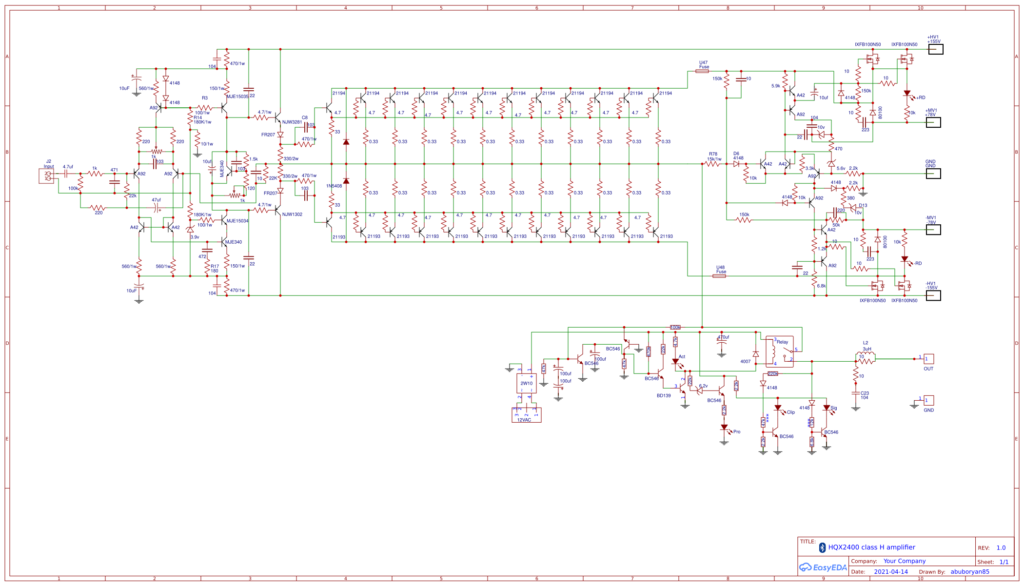
Advantages:
- Improved efficiency over Class AB
- Reduced power dissipation
Disadvantages:
- More complex design
- Costlier components
Applications:
- High-power audio amplification
- Professional audio equipment
Comparison of Amplifier Classes
| Amplifier Class | Linearity | Efficiency | Distortion | Heat Dissipation | Typical Applications |
|---|---|---|---|---|---|
| Class A | Excellent | Low (20-30%) | Very Low | High | High-fidelity audio, low-noise circuits |
| Class B | Moderate | High (70%) | High (Crossover) | Moderate | Audio amplification, RF transmission |
| Class AB | Good | Moderate (50-70%) | Low | Moderate | Consumer audio, RF amplification |
| Class C | Poor | Very High (up to 90%) | Very High | Low | RF transmission, oscillators |
| Class D | Moderate | Very High (90%+) | Moderate | Very Low | Portable audio, subwoofers |
| Class G/H | Good | High | Low | Moderate | Professional audio, high-power amplification |
Conclusion
Selecting the appropriate amplifier class depends on the specific application requirements, such as the need for efficiency, linearity, and power handling. While Class A amplifiers are preferred for high-fidelity audio due to their excellent linearity, Class D amplifiers are ideal for portable and battery-operated devices where efficiency is paramount. Understanding these trade-offs helps in designing and choosing the right amplifier for your needs. I hope this overview on different classes of amplifiers has helped you make good choices in your selections.
Ready to take a dive into Electrical Engineering to get a head start on College or University, or simply expand your DIY knowledge?
Check out our meticulously designed course in Electrical/Electronic Engineering for all walks of life, from any country. Delivered by Professor F. Tavassoli.

Join students and professionals
from across the world increasing their knowledge of Electrical Engineering.
One email at a time
We never send spam or give your information to anyone, Privacy Policy here.

